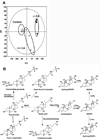FXR signaling in the enterohepatic system
- PMID: 22609541
- PMCID: PMC3491147
- DOI: 10.1016/j.mce.2012.05.004
FXR signaling in the enterohepatic system
Abstract
Enterohepatic circulation serves to capture bile acids and other steroid metabolites produced in the liver and secreted to the intestine, for reabsorption back into the circulation and reuptake to the liver. This process is under tight regulation by nuclear receptor signaling. Bile acids, produced from cholesterol, can alter gene expression in the liver and small intestine via activating the nuclear receptors farnesoid X receptor (FXR; NR1H4), pregnane X receptor (PXR; NR1I2), vitamin D receptor (VDR; NR1I1), G protein coupled receptor TGR5, and other cell signaling pathways (JNK1/2, AKT and ERK1/2). Among these controls, FXR is known to be a major bile acid-responsive ligand-activated transcription factor and a crucial control element for maintaining bile acid homeostasis. FXR has a high affinity for several major endogenous bile acids, notably cholic acid, deoxycholic acid, chenodeoxycholic acid, and lithocholic acid. By responding to excess bile acids, FXR is a bridge between the liver and small intestine to control bile acid levels and regulate bile acid synthesis and enterohepatic flow. FXR is highly expressed in the liver and gut, relative to other tissues, and contributes to the maintenance of cholesterol/bile acid homeostasis by regulating a variety of metabolic enzymes and transporters. FXR activation also affects lipid and glucose metabolism, and can influence drug metabolism.
Published by Elsevier Ireland Ltd.
Figures



References
-
- Seol W, Choi HS, Moore DD. Isolation of proteins that interact specifically with the retinoid X receptor: two novel orphan receptors. Mol Endocrinol. 1995;9:72–85. - PubMed
-
- Forman BM, Goode E, Chen J, Oro AE, Bradley DJ, Perlmann T, Noonan DJ, Burka LT, McMorris T, Lamph WW, Evans RM, Weinberger C. Identification of a nuclear receptor that is activated by farnesol metabolites. Cell. 1995;81:687–693. - PubMed
-
- Wang H, Chen J, Hollister K, Sowers LC, Forman BM. Endogenous bile acids are ligands for the nuclear receptor FXR/BAR. Mol Cell. 1999;3:543–553. - PubMed
-
- Makishima M, Okamoto AY, Repa JJ, Tu H, Learned RM, Luk A, Hull MV, Lustig KD, Mangelsdorf DJ, Shan B. Identification of a nuclear receptor for bile acids. Science. 1999;284:1362–1365. - PubMed
-
- Parks DJ, Blanchard SG, Bledsoe RK, Chandra G, Consler TG, Kliewer SA, Stimmel JB, Willson TM, Zavacki AM, Moore DD, Lehmann JM. Bile acids: natural ligands for an orphan nuclear receptor. Science. 1999;284:1365–1368. - PubMed
Publication types
MeSH terms
Substances
Grants and funding
LinkOut - more resources
Full Text Sources
Other Literature Sources
Molecular Biology Databases
Research Materials
Miscellaneous

